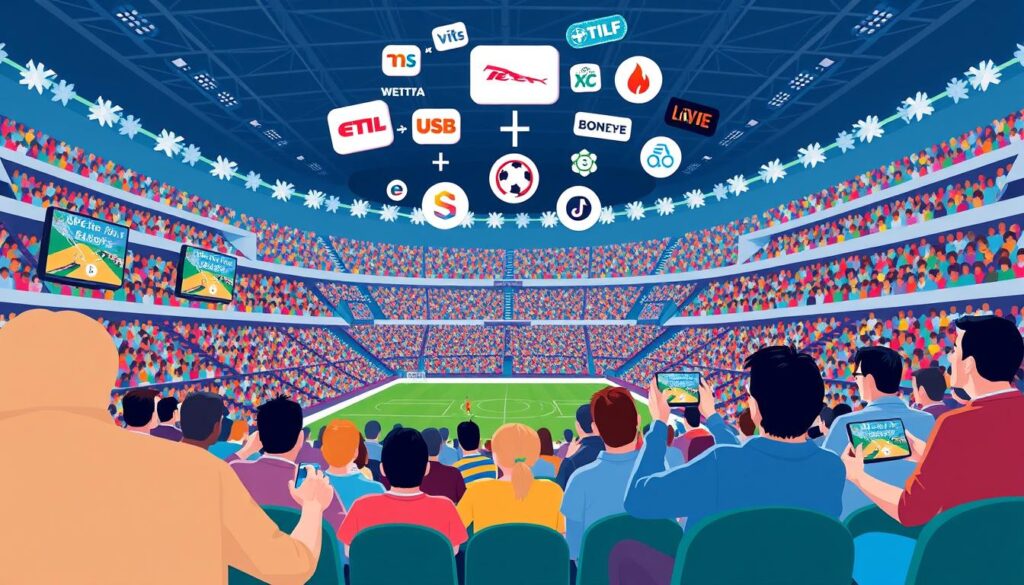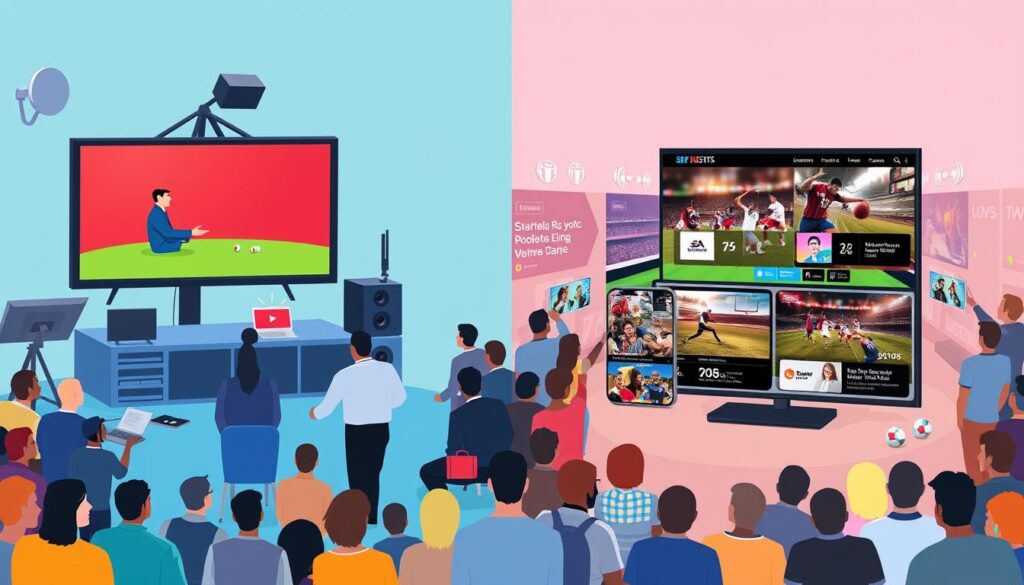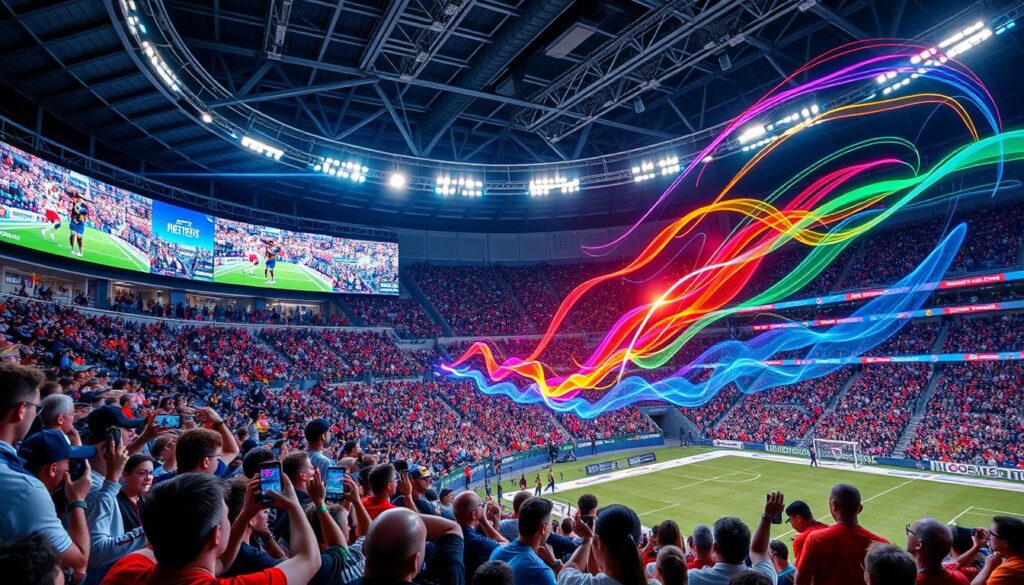“The future belongs to those who believe in the beauty of their dreams.” – Eleanor Roosevelt. Today, streaming services are changing sports broadcasting fast. You might wonder how these changes affect your favorite teams and events. This article explores how streaming technology is transforming sports broadcasting.
Platforms like Peacock and Amazon Prime Video are changing how we watch sports. Fans no longer need cable to see live games. They can watch sports anytime, anywhere, changing how we connect with our favorite athletes.
This article will show how sports broadcasting is evolving. We’ll see how innovations are opening new ways for fans, teams, and networks. For example, NBC Sports Philadelphia offers live Flyers games and streaming, blending old and new sports viewing.
As we explore this new world, you’ll learn how streaming is changing sports broadcasting. It’s making sports more engaging and enriching for everyone123.
The Rise of Streaming Services in Sports Broadcasting
Streaming services have changed the sports broadcasting world a lot. They have become very popular, making big networks rethink how they work. Now, more people want to watch sports when and where they want, not just on TV.
ESPN+ and DAZN are at the forefront, offering content straight to viewers. They show how the sports world is changing, focusing on streaming technology. These services make a lot of money for leagues and teams by understanding what viewers like.
Numbers show how streaming is changing sports TV. More people are watching online instead of on TV. To stay ahead, sports groups need to get with the times and use new streaming tech. This way, they can keep the interest of today’s viewers4.

Understanding the Impact of Streaming Services on Sports Broadcasting
Streaming services are changing sports broadcasting a lot. More people are moving from traditional cable to streaming. This change is not just about how we watch sports. It’s a big sports media digital transformation.
The impact of streaming services on sports broadcasting is clear in how networks make money. With more people joining ESPN+ and Peacock, old ways of making money are struggling. Networks are now focusing on subscriptions instead of ads.
Subscription prices are being looked at again. This is because people want more flexible viewing options. Networks are working hard to keep viewers interested. They offer special content, behind-the-scenes looks, and on-demand viewing.
The sports media digital transformation is changing how we watch sports. Streaming platforms use advanced analytics and personalized experiences. This changes how fans interact with their favorite games.

The future of sports broadcasting is all about embracing these changes. You can expect even more changes as networks keep up with what viewers want in the digital age.
“In the ever-changing realm of sports broadcasting, understanding the impact of streaming services is crucial for anyone engaged with sports media.”5
Shifting Consumer Behavior Around Sports Viewership
Modern technology has changed how we watch sports, moving away from old habits. More people now prefer on-demand viewing for its flexibility and ease. This change shows how the sports world is moving towards instant content.
Younger viewers especially like mobile access and interactive features. These are things traditional TV can’t offer.
As tastes change, live sports streaming is affecting many areas. It’s changing not just how we watch sports but also what content is popular. Services like ESPN+ and Peacock are offering unique events, letting viewers pick what they want to see.

The sports viewing world is always changing, with new streaming options popping up. People want easy access and content that fits their needs. This has made leagues and broadcasters rethink their plans.
This shift will likely lead to more new ideas in the sports world. It shows how quickly consumer tastes can change.
Understanding these shifts enables stakeholders to anticipate viewers’ needs, driving future innovations in both technology and content delivery.
The way we watch sports is changing, showing a big shift in how we value sports. This change is not just about how we watch but also the value and experience of sports itself6.
Streaming Technology in Sports: Key Innovations
Streaming technology in sports has changed how fans watch live games. New features on platforms like YouTube TV and Hulu with Live TV make watching sports better. These changes make sports more accessible and interactive for everyone.
Live Sports Streaming Platforms
Live sports streaming platforms have changed how we watch sports. They offer many features, such as:
- Multiple camera angles for a more immersive experience.
- Customizable viewing options that cater to individual preferences.
- Real-time stats and commentary that enhance the viewing experience.
This shows how live sports streaming has improved fan satisfaction and loyalty.
Mobile Streaming Applications
Mobile streaming apps make sports available anywhere, anytime. They focus on making it easy and quick to watch live games. Features include:
- Live updates and notifications for your favorite teams and leagues.
- Options for streaming on various devices, ensuring flexibility.
- User-friendly interfaces that cater to all types of viewers.
The rise of mobile apps meets the needs of today’s viewers. It shows how important streaming technology is in sports, aiming to offer quality and convenience.

Sports Broadcasting Innovations Driven by Streaming
Streaming services have changed sports broadcasting a lot. They’ve brought in new ways to engage viewers, like cool graphics and real-time stats. Amazon Prime Video and NBC Sports are leading the way with augmented reality, making games more interactive.
These changes have made watching sports more fun for everyone. Even casual fans are drawn in by the modern approach. Now, fans can see how players are doing in real time, which makes the game more exciting.
Streaming is also making sports more personal. Fans can pick how they want to watch their favorite teams. This means they can see games from different angles and hear from various experts.

| Innovation | Description |
|---|---|
| Augmented Reality | Utilizes AR overlays during broadcasts to provide real-time statistics and immersive visuals. |
| Interactive Statistics | Allows viewers to engage with live data regarding player performance and game metrics. |
| Enhanced Commentary | Employs various commentators and expert analyses to provide deeper insights into games. |
| Customizable Viewing Angles | Gives viewers control over their preferred camera angles during broadcasts. |
As streaming technology in sports keeps getting better, we’ll see even more cool stuff. These new technologies show how broadcasting can meet today’s viewer needs7.
Comparing Traditional Sports Broadcasting to Streaming Services
The shift from traditional sports broadcasting to streaming services changes how we watch media. Traditional broadcasters make money from ads, while streaming services charge users a monthly fee.
How people engage with content also varies. Streaming services can see how users interact with their content, which traditional networks can’t. This lets streaming services offer content that fits what viewers like, making their experience better.
This change shows a bigger trend in the sports world. Traditional networks still draw big crowds for live games. But streaming services are winning over younger viewers who like watching when they want to. Streaming services are changing sports broadcasting by offering viewers more control over when they watch games.
| Aspect | Traditional Broadcasting | Streaming Services |
|---|---|---|
| Revenue Model | Advertisement-based | Subscription-based |
| Viewer Engagement | Limited metrics | Detailed analytics available |
| Audience Demographics | Older audience | Younger audience |
| Viewing Flexibility | Scheduled programming | On-demand accessibility |

As the competition grows, both traditional broadcasting and streaming services keep changing. They each have their own good points and weaknesses. These differences shape what sports fans want to watch, guiding the future of sports broadcasting8.
Live Sports Streaming Impact on Viewership and Revenue
The way fans watch sports is changing fast. More people are choosing streaming over TV because it’s more flexible. This change is affecting how sports networks and leagues make money, as ads struggle to find their audience online.
As sports media keeps evolving, leagues are focusing more on digital content. They want to stay relevant in a world where media is always changing. With more people subscribing to streaming services, leagues must find new ways to connect with fans. Fans want to watch what they want, when they want it. This changes how leagues deal with broadcasting rights and partnerships.

| Aspect | Traditional Broadcasting | Streaming Services |
|---|---|---|
| Viewer Engagement | Limited options for interaction | Enhanced interactivity through apps |
| Accessibility | Set schedule | On-demand viewing |
| Advertising Revenue | Stable but declining | Growing but fragmented |
| Subscription Models | Ad-supported | Monthly subscriptions |
Being able to adjust to these changes can make fans happier and increase your earnings. It’s key to understand the digital shift in sports broadcasting.
“The evolution of consumer behavior is forcing traditional networks to rethink their strategies.”
This ongoing change shows how important it is to stay up-to-date in the sports media world. The impact of live sports streaming is not just a trend; it’s the new norm.
How Major Leagues are Adapting to Streaming Trends
The world of sports broadcasting is changing fast. The NFL and NBA are leading the way by adapting to what viewers want. They’re changing how they sell broadcast rights and who they partner with.
Changes in Broadcast Rights and Partnerships
Leagues are now focusing on getting streaming rights. This move helps them make more money as streaming becomes more popular. More fans are choosing to watch games online than on TV.
Many leagues are starting their own streaming services. This shows they want to reach fans directly. It’s a big change in how they connect with viewers.
Collaborations with Streaming Giants
Working with big streaming services is key for sports today. Leagues are teaming up with Amazon and others. This shows where sports content is headed.
Streaming services are growing fast. Leagues see the value in partnering with them to attract younger fans. Online sports ads are now as valuable as TV ads. This change shows streaming’s big role in sports today91011.

Emerging Sports Media Digital Transformation Trends
As you explore the sports media world, new trends from digital transformation are key. These changes are making how fans connect with their teams and events different. The role of streaming technology in sports is crucial, opening up new ways to watch and interact with sports.

- Personalization of content through data analytics, enhancing viewer satisfaction.
- Increased use of artificial intelligence to recommend content based on individual preferences.
- Enhanced mobile capabilities, allowing users to access sports broadcasts anywhere.
- Real-time fan engagement opportunities via interactive streaming features.
These changes are big. Everyone needs to keep up to stay relevant and meet fan expectations. By embracing sports media digital transformation, networks and teams can offer fans deeper, more engaging experiences.
| Trend | Description | Impact on Viewers |
|---|---|---|
| Personalization | Tailoring content using big data analytics. | Higher viewer satisfaction and retention rates. |
| AI Integration | Using AI for content recommendations. | More relevant viewing suggestions. |
| Mobile Capabilities | Accessing content via mobile devices. | Increased access to sports anytime, anywhere. |
| Interactive Streaming | Engaging fans through interactive features. | Enhanced viewer loyalty and participation. |
As these trends grow, sports broadcasting will see big changes. It’s vital for everyone to adapt to these shifts to succeed in the digital world. The mix of streaming technology in sports and digital strategies is shaping the future of sports viewing.
The Role of Social Media in Live Sports Coverage
Social media has changed how we watch live sports. Now, fans get live updates on Twitter and Instagram. This makes watching sports more exciting and interactive.
Social media tools help fans get involved in sports. During big games, hashtags and tweets create a buzz. This helps events trend and brings fans together.
Organizations use social media to promote sports events. They share behind-the-scenes content and start conversations. This makes fans feel part of the action.
Traditional broadcasters must keep up with these changes. They need to offer instant updates and interactive content. This mix of old and new ways is key to reaching more people.

Social media has become an essential tool for delivering live sports coverage, providing fans with unprecedented access to their favorite games and athletes.
In short, social media is vital for live sports coverage today. It keeps sports media fresh and connected to what fans want12.
Challenges Faced by Traditional Broadcasters
The world of sports broadcasting is changing fast. Traditional broadcasters face many challenges as they try to keep up with streaming. Streaming services are changing what viewers want, making it hard for old TV models to compete.
This change means traditional broadcasters must find new ways to grab viewers’ attention. They need to compete with streaming services that offer more personalized experiences.
Adapting to the Streaming Model
Traditional broadcasters must innovate to stay relevant. They need to add digital elements to their broadcasts. Viewers want more control over what they watch, which old methods can’t always provide.
To meet these needs, broadcasters are mixing old ways with new tech. They’re creating hybrid models that offer both traditional and streaming options. This change requires new tech and a shift in how they work.
They also need to understand what viewers want better. This means studying viewer habits and preferences. As streaming gets better, traditional broadcasters must make content that appeals to today’s viewers.

| Challenge | Potential Response |
|---|---|
| High competition from streaming services | Enhanced content delivery methods |
| Viewer fragmentation | Data-driven audience engagement strategies |
| Technological advancements | Investment in streaming infrastructure |
| Changing viewer expectations | Personalization of viewing experiences |
Traditional broadcasters must face these challenges head-on to survive. Their success depends on their ability to adapt to the changing audience13.
Future of Sports Broadcasting in the Streaming Age
The world of sports broadcasting is about to get a lot more exciting. Streaming services are changing everything. We’re seeing new trends and technologies that meet what viewers want.
Predicted Trends and Innovations
One big change is more content made just for certain groups. Things like augmented reality are making watching sports more fun. Soon, you’ll be able to watch live games or catch up later, whenever you want.
Leagues are also adjusting prices to make sports more accessible. This is all about finding a balance between keeping fans happy and making money. Schools in the Big Ten Conference are teaming up to help, showing how sports can bring people together14.
Streaming services are now offering more than just sports. They’re adding content that helps the community, like blood drives. This attracts a younger audience and shows how sports can make a difference14.

As sports organizations adapt to the digital landscape, the emphasis on innovative broadcasting methods will redefine the viewer experience.
Regulations are also playing a big role in the future of sports broadcasting. Changes in Minnesota show how important it is for sports to stay connected with their fans15.
Case Studies of Successful Streaming Service Integrations
Looking at specific cases shows how streaming services have changed sports broadcasting. The NFL’s Game Pass and NBA League Pass are great examples. They bring new ways for fans to enjoy sports, making the experience better than ever.
These services use live streaming, alternative commentaries, and behind-the-scenes content. This mix has a big impact on how viewers enjoy sports. They show how important it is to keep up with new trends to keep fans interested.
| Service | Key Features | Viewer Engagement Strategies |
|---|---|---|
| NFL Game Pass |
|
|
| NBA League Pass |
|
|
These examples show the power of live sports streaming. They offer content that fans love, making the experience better. This keeps these platforms leading in sports engagement.

Global Impact of Streaming on Sports Broadcasting
Streaming services have changed how we watch sports around the world. Places like Europe and Asia are leading this change. They’re seeing new ways to show sports and how fans watch them.
More people want to watch sports when they want, not just when it’s on TV. This change is making old TV models seem outdated. Networks and leagues are now thinking about new ways to reach fans.
International teams are working together more than ever before. They’re teaming up with big names like Amazon Prime Video and DAZN. This helps them reach more fans and grow their audience.
This shift to digital is big for sports broadcasting. It makes watching sports easier and opens up new ways to share content. It’s making sports more global and exciting for everyone involved1617.

